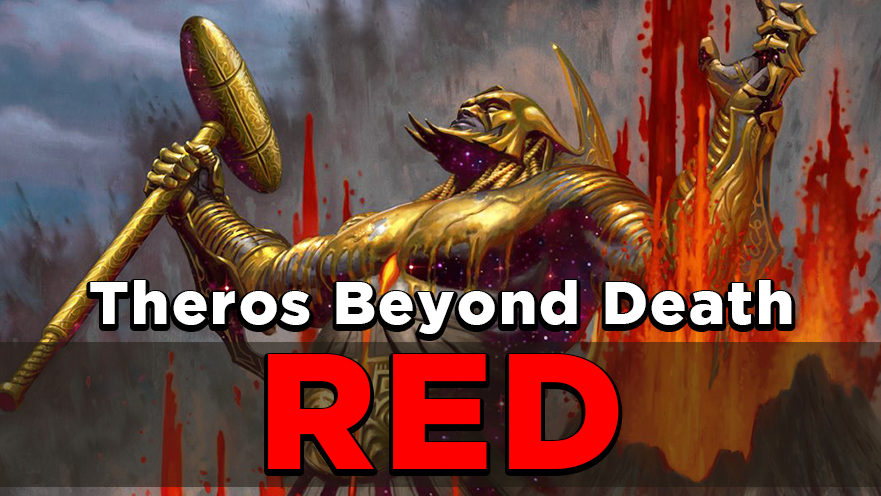Welcome to 2020, Magicians and Planeswalkers! Wizards kicked off a new decade of Magic with a bang, flooding the internet with spoilers for the next Standard set over the past few days.
Spoiler season is always an exciting time for the community, offering players the thrill of “discovering” the game again and promising those tired of current metagames some relief. Throne of Eldraine has certainly had its time in the sun, showing a historic level of dominance in all formats and prompting speculation about the power of future sets.
Anyone who’s been reading my articles for the last few months of 2019 will know that the last year sparked a number of important questions for the future direction of Magic design. The spoiler season for Theros Beyond Death is our first glimpse at how Wizards wants to tackle the next decade, and that is as compelling a reason to follow along as excitement for the new cards or the return to the plane’s unique classical theme.
To help you get a coherent view of Theros Beyond Death, I’ll be publishing a guide to the most significant spoilers in each color. I won’t be discussing every card, or even every rare! But I will be looking to these spoilers as an oracle: assessing their impact on various formats and what they imply about the archetypes and mechanics which will be prominent in the months to come.
Today, we kick things off with a look at what red has received so far — and how this set is playing with fire when it comes to card design!
ESCAPE FROM THE UNDERWORLD
Even for those unfamiliar with the lore of Magic’s last visit to Theros, the subtitle Beyond Death implies a lot about the mechanical themes of the set. This is a story about the denizens of the underworld bursting into the land of the living, and the marquee keyword “escape” reflects this. Since red is not a great color for exploring the set’s other major theme — enchantments — it seems to have gotten the chimera’s share of pushed escape cards.
Escape offers an alternative cost to cast spells out of your graveyard. This sometimes creates an alternative effect (like entering with +1/+1 counters), but always requires some number of other cards to be exiled from your graveyard as part of the cost. On the other hand, there’s no extra clause to exile the escaping card once you’ve used it this way. Given fuel, the same card is able to escape repeatedly!
Using the graveyard as a resource is always one of the most risky things a mechanic can do. Still, there are a few checks and balances in play. First is having a unique cost for each card, both in mana and cards to be exiled. This makes R&D’s task much easier, and allows different escape cards to play differently based on how demanding their cost is.
The second is that the cost includes exiling cards at all. This is a fascinating choice, which will determine the power of these cards in older formats (where it is far easier to fill up a graveyard quickly), as well as how they are used in different decks. Ordinary midrange and control decks might take advantage of a single escape threat for inevitability, eating up the cards which have been spent over the course of the game. Meanwhile, a dedicated escape deck will need to choose which cards to prioritize and which to exile, while also playing spells that can fill the ’yard quickly.
Phoenix of Ash
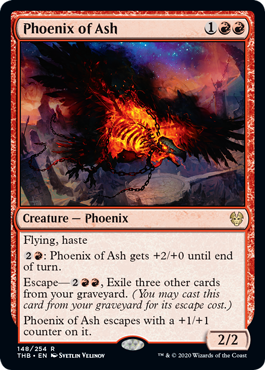
Phoenix of Ash seems designed for the former kind of deck — it’s a generally strong card which provides a resource sink in grindy games. With a Phoenix in the ’yard, you’ll always be able to pay its mild escape cost and then dump any remaining mana into a hasty, fire-breathing attack. If there is a slower red deck like Big Red or Chandra Tribal, it will fit in well.
Ox of Agonas
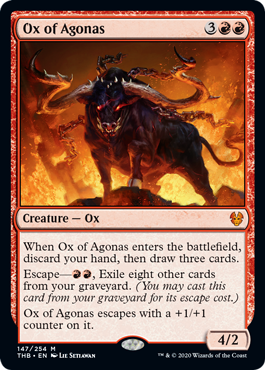
The Ox of Agonas is even more powerful, and will absolutely have implications for eternal formats as an enabler for Dredge, Hollow One, and other such discard-focused decks. Being able to discard your entire hand for two mana AND draw cards to replace it is a powerful enough effect that even more degenerate graveyard-based combos could be interested. In Standard, this will provide both fuel and payoff for escape-focused strategies. But any red deck capable of emptying its hand could be interested in a repeatable Bedlam Reveler.
The only weaknesses of this Ox are its clunky CMC and low toughness. I would expect Scorching Dragonfire and Lava Coil to become main deck staples once this set comes out, and the Ox is one of the main reasons why.
SNEAKING ETERNAL STAPLES INTO STANDARD
One thing which has gradually become the new normal for Standard sets is the appearance of cards which seem more in line with older formats like Modern and Commander. While these cards are often playable in Standard, it’s equal parts intriguing and nerve-wracking to see effects powerful enough to dominate Legacy popping up in spoilers. Standard Sneak Attack, anyone?
Purphoros, Bronze-Blooded
The OG Purphoros is no slouch, as many Commander players can tell you. But this guy is something else, immediately calling to mind the powerful Sneak and Show Legacy deck. Purphoros also has implications for Fires of Invention in Standard: CMC 5 is the sweet spot for free spells to come down the turn after the powerful enchantment, and Purphoros even provides an activated ability that will give you something to do with your mana. Cavalier of Flames plus any third red creature will make Purphoros a creature with mana to spare, providing a very plausible one-hit KO!
Terror of Mount Velus
Even in less ideal situations, the ability to cheat a giant threat into play can be devastating, even for a single attack. My past meditations on Drakuseth Reanimator have demonstrated that value, and Terror of Mount Velus might be the next-best option for any similar strategy in Standard. In fact, Purphoros will allow the deck to play an effective midrange game instead of going all-out for the combo kill, which is very exciting. Expect Mono-Red Fires and Purphoros to be a thing people try in Standard — and perhaps in Pioneer and Modern, where he could give a bump to older Through the Breach strategies.
Underworld Breach
Another card which seems to have escaped from Magic’s combo past, the appropriately named Underworld Breach is a question-mark for Standard but a surefire slam-dunk for Legacy. Calling to mind the absolutely terrifying Yawgmoth’s Will, this combo-y enchantment hits some nice notes for unusual enchantment design that I wanted to see explored while we’re on Theros.
Since Underworld Breach is a permanent, you can repeatedly re-cast ANY spell and create a galaxy of combo kills. But this is also a new weakness for this sort of card — sure, you can demonstrate your intent to loop Lion’s Eye Diamond and Brain Freeze until you can mill your opponent’s entire deck, but what if they Disenchant your Underworld Breach when your first Diamond hits the stack? Opening up active combo counterplay to colors which can’t play discard or counterspells is something I advocated just last week, and this is a great, natural way to achieve that!
COGS FOR THE BIG RED MACHINE
Red is known for low-to-the-ground aggression; the “Red Deck Wins” epithet is rarely attached to decks with a curve higher than three or four mana. But the occasional slower red deck is a treat which tempts many players, most recently seen in the days of Glorybringer wrecking Standard.
Neither of these cards plays the same role as ol’ “Glory B” (that combat-ruining finisher slot is currently filled by Embercleave), but they suggest that a Big Red deck might exist in Theros Beyond Death Standard.
Tectonic Giant
Tectonic Giant is just cheap enough to be a curve-topper for a more aggressive red aggro build, but it’s hard to see it displacing Torbran, Thane of Red Fell in those lists. Its stats for combat are a little below curve, and cards like Experimental Frenzy and Chandra, Fire Artisan will still be legal if card advantage is needed. No, this is a fundamentally midrange-aimed design, with both abilities guaranteeing a good return on investment no matter what happens to our magmatic pal. And for our FNM jank-lovers, this might be the final piece of the puzzle to make Naya Giant Tribal a reality!
Storm’s Wrath
Storm’s Wrath is a fairly straightforward card, albeit a refreshing one. We haven’t had a red sweeper in a while outside of Gates Ablaze, which unfortunately puts sharp limitations on deck design. Four damage is close enough to a board wipe for most of Standard and is more efficient when costed this way as opposed to the usual XR for X damage. Plus, the ability to kill most of the 3-CMC Planeswalkers will have ramifications for eternal formats, and helps to answer another big question I had coming out of Magic’s volatile 2019.
CAN’T HAVE A SET WITHOUT CYCLES
Wizards often designs cards in “cycles,” where a card of one color is mirrored by cards of similar cost, type, and templating in each of the other four. So it has been since the days of Lightning Bolt/Giant Growth/Healing Salve/Ancestral Recall/Dark Ritual in Alpha; so it shall be until the end of time. And here are the red installments for two of the big cycles we’ll be getting in this set.
Purphoros’s Intervention
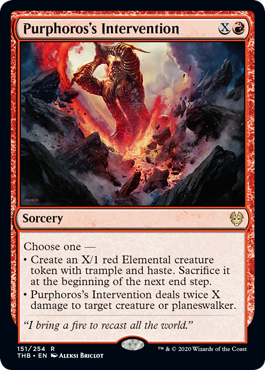
The “Intervention” cycle are all X-cost sorceries which offer a choice between two distinct modes. At rare, they can be pushed enough to match the Constructed impact of their cousins in the “Command” cycle, and Purphoros’s Intervention is one of the strongest we’ve seen.
There are two big factors that determine how these cards will fare: how well the modes complement each other strategically, and how well it scales for large and small values of X. This Intervention passes both tests. The removal mode can clear an opposing board, and the other mode follows up once you’ve removed the blockers. And for efficiency, the card is already “mediocre playable” at X=1, improving rapidly from there. Only being sorcery speed can hold this back.
Omen of the Forge
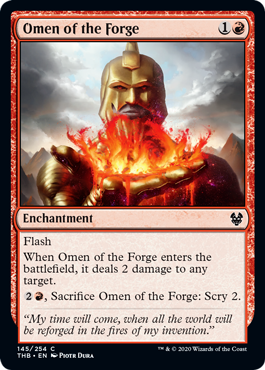
The “Omen” cycle of enchantments have effects that we’re used to seeing on instants. I love this kind of design and asked for as much in my “Enchantments Matter” article, so I’m excited to see how they play out. Omen of the Forge isn’t a mind-blowing piece of removal, but depending on how many enchantment or devotion payoffs there are for red, it could certainly earn its place. The ability to “cash in” the lingering enchantment to scry 2 if you can’t get any other value is a nice touch. We’ll come back to see which color gets the most out of this cycle later on.
JUMP IN THE JANK TANK
After the pushed Constructed cards and obvious Limited bombs, what we have left are the forgotten-gems-in-the-making; the secret sauce; the spicy meatballs. What Wizards calls “Johnny cards” often end up being the perfect card for a small subset of Commander players or Cube builders. Let’s see who’s getting lucky with Theros Beyond Death jank.
Storm Herald
Storm Herald has a powerful, open-ended effect at a very reasonable mana investment, likely printed into Standard because Wizards feels there’s no way to break it. Unfortunately, I’d wager they’re mostly right. The parasitic nature of auras means that it’s very difficult to build around them, since you also need the right number of creatures to make them castable.
Storm Herald also only attaches auras to your creatures, denying you the chance to cash in by playing removal auras like Dead Weight. The temporary and exile-bound nature of the returned auras even stops potential abuse of something like Unholy Indenture to make Storm Herald immortal. When the best auras you can return are Gift of Paradise and Angelic Gift, you’re not really at the power level of current Standard. Still, Theros Beyond Death has an enchantment theme, so the idea of strong auras is not out of the question.
In older formats, Storm Herald has more potential as a fast, combo-promoting threat, almost certainly based on recurring this card:
Deathbellow War Cry
Deathbellow War Cry, which will be available in special Theme Boosters (along with Terror of Mount Velus), is a payoff for Minotaur Tribal decks. Fetching four different minotaurs is very Commander friendly, as is the eye-watering CMC of eight. Fetching up Rageblood Shaman, Anaba Spirit Crafter, Kragma Warcaller and Neheb, the Eternal leads to a pretty hefty attack for your Neheb, the Worthy deck. At least now opponents will have to respect the tribute trigger on your Oracle of Bones!
NOW UNTO HELIOD GO
These spoilers are coming out thick and fast; already, we’re starting to see Wizards answer some of our burning questions about what Magic will look like in 2020.
Likewise, I won’t ask you to wait too long for the next set of Theros Beyond Death preview reviews. Come back later this week to get the low-down on upcoming white cards, including some incredible new legends which look set to shape various Constructed formats for the rest of the year!

Tom’s fate was sealed in 7th grade when his friend lent him a pile of commons to play Magic. He quickly picked up Boros and Orzhov decks in Ravnica block and has remained a staunch white magician ever since. A fan of all Constructed formats, he enjoys studying the history of the tournament meta. He specializes in midrange decks, especially Death & Taxes and Martyr Proc. One day, he swears he will win an MCQ with Evershrike. Ask him how at @AWanderingBard, or watch him stream Magic at twitch.tv/TheWanderingBard.

